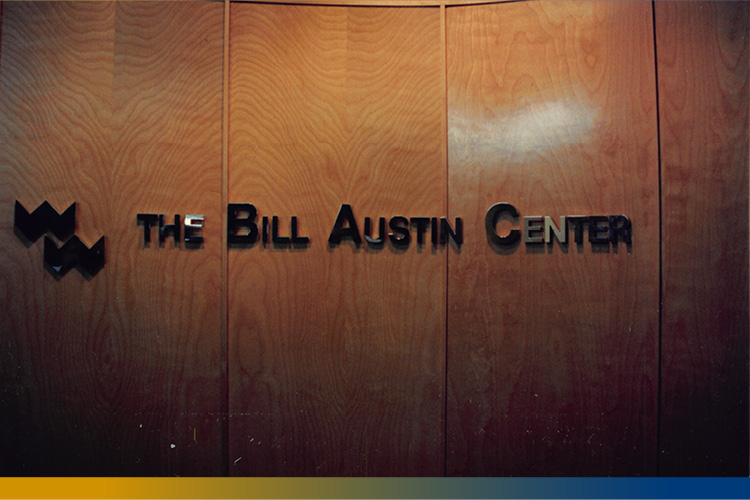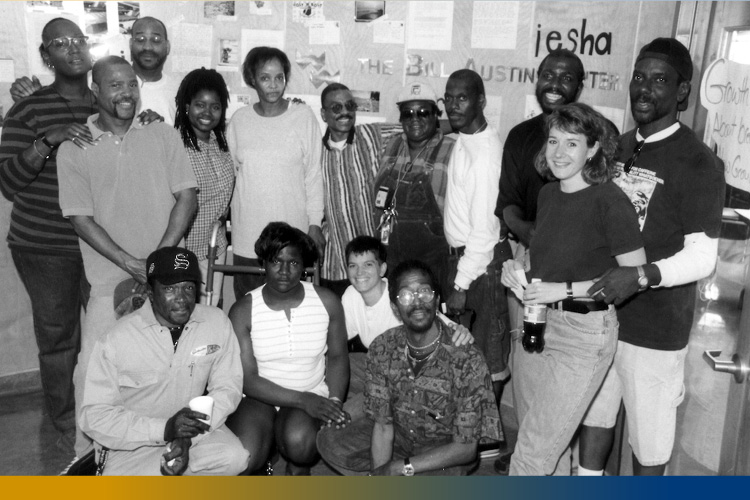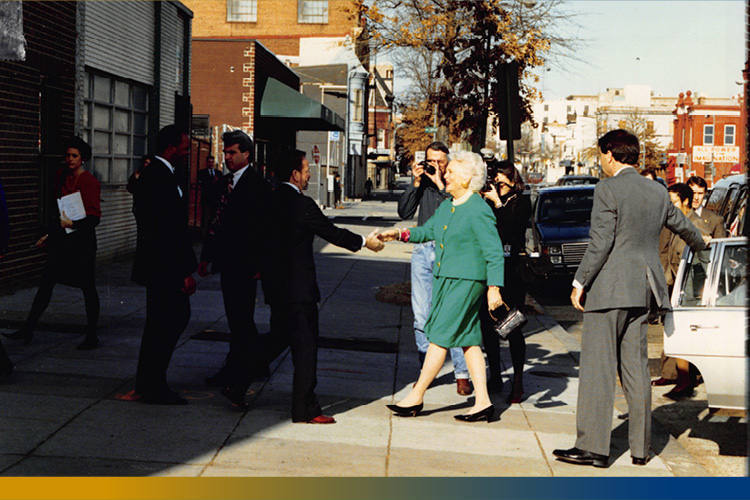As part of Whitman-Walker’s 40th anniversary, officially January 13, 2018, we’re sharing 40 stories to help tell the narrative of the Whitman-Walker community. This week we’re highlighting multiple voices from Whitman-Walker to tell the story of the Bill Austin Day Treatment and Care Center. Bill Austin was a DC-based architect living with AIDS who envisioned a place that provided care and compassion for others impacted by the disease. In 1991, Whitman-Walker Clinic dedicated funds to create an outpatient care center for people living with AIDS. It would reflect Bill Austin’s vision and uplift his name. The Austin Center offered clients a stigma-free space to receive care, play cards, take field trips and spend their days in the company of others. Listen and read long as members of the Whitman-Walker community remember the Austin Center!
D. Magrini – a Whitman-Walker employee and former Austin Center volunteer, recalls a special moment with an Austin Center community member:
“But I got to sit out – especially during the summer and spring months – got to sit outside and hang out with clients and at that point for some of them, that Austin Center community was the only place they had that they were not ostracized, that people would sit next to them, eat with them, hang out with them, be about them, you know? It was almost like the illness was so big, and the Austin Center – the presumption of the virus was so big that you could kind of cut through and then just get to the person. That was already the presumed situation. So, now I’m just going to sit with Ms. Mary over here or Ed over here, and that’s what we do.
I can. I can. I can, I can. Oh, and the brother’s name just popped right out of my head, but here’s the deal. This brother had been a high fashion model, a black man at a time when black men were not high fashion models. His facial structure was very European in the angle of his nose, the cut of his jaw. I mean, he was clearly African American, but he had that classic – what’s thought of as classic European features: tall and slender and all that stuff. So, he got work in ways that a lot of – he was just ahead of that pack, but he got ill and he came home from New York and his family cared for him. His mom was a fantastic caregiver; in fact, his mom was who brought him to the Austin Center when his care and his medications really demanded more than she was able to do, and so it was like she brought him, but she wanted to check out – was this going to be an okay place to leave her grown son, you know? It was that kind of interaction. Like, ‘I’m not just dropping him off over here. I need to look at y’all and see if you’re going to treat him like a human being over here and they’re not – I don’t need to come get him,’ or whatever needs to happen. But anyway. When he was feeling well – and sometimes even when he wasn’t – and this is true for a number of the guys there – they were sharp-ass dressers. Jesus Christ, yes. The would buff themselves up, they would do whatever. I don’t know what it was about, really, but some people would just take great pride in that. And he took great pride in his appearance but he also had a really good sense of humor about his appearance, kind of like I do. I just think clothing and all that stuff is funny, I think, at the very end of it. You know? And I had recently bought a pair of Nocona boots – which are still in my closet, I will tell you – that I told Cynthia [D’s partner at the time] – I believe I told Cynthia those boots cost $50.00. Those boots were in excess of $270.00, but I had to have the boots. I had to have the goddamn boots and so I bought the goddamn boots, and I – yeah, because I was really about looking good, too. I was about it, and I was about those boots. I came around the corner and I’m wearing my boots and I’ve got my jeans on and everything’s everything that day. I think my hair was freshly cut down. I was looking good. I come around the corner and he is wearing his boots, his cowboy jeans, but he’s got on the whole rig down to pony vest and hat. You see what I’m saying? So, there’s two black gunslingers meeting at the corner of 14th Street and
we start doing the cowboy dance in the street, just on the sidewalk, just – we’re doing this loopy little thing and he’s so thin, and this is like – this is a guy that was often not able to walk from 14th and U to the building, but we were dancing. We were dancing, and it was really, seriously all right. It was seriously all right. Allen, that’s his name. Yep.”

Joanne Sincero – a former Austin Center employee, and current Whitman-Walker employee recalls a typical day:
“Yeah. There was never a day, I think in all my 18 years being there that there wasn’t a story. I miss that now ’cause sometimes I can have just a day and it’s like, ‘Really, nothing all that monumental happened today.’ But in Day Treatment, every day there was something. It was either something awesome or something where you were like, ‘Oh, that was a nightmare; I’m not going to do that again.’ I always think about this because I have friends who work in the nonprofit world, but more in the middle level, not with direct care. You always knew whether somebody liked something or they hated it, or it was a good day or it was a bad day. There was a lot of – we did a lot around eating, especially back in the day when people were really trying to get some calories. It was really a way to connect with people – around a cup of coffee, around breakfast, around lunch. That time was so, so important. I really learned from that – taking people out in the community and going on a trip with people. You could find out so much sometimes, having people go into another environment or doing something maybe like, ‘Oh, I remember this. When I was five I such-and-such,’ and it would trigger a memory for them to tell a story.
A typical day – as it went along the program got more robust and we did a lot more things, but it definitely centered around making sure that we had good nutritious food for people. In the very beginning, some of the days were like people were so ill we thought there would be certain people that we thought they might die that day. So we would have a plan. ‘If so-and-so dies, wheel him into the nursing station. You go down and talk to the clients. You do this.’ We had the whole thing divided up because it was just a real possibility.
There wasn’t this sense of ‘You’re sick; you should stay home.’ It was, ‘You’re sick, but you might as well be sick out in the world.’ It wasn’t like you were necessarily going to be sick and then you were going to get better. It was a kind of a trajectory in a certain way. I remember we had a lot of IV poles and people went outside out front, in front of the clinic. They would go to the carry-out with the IV pole. Being their normal lives so much of I think; otherwise, it could have seen such a terrifying, lonely, and scary time in their lives – if people were able to get better. But if not, they at least were able to still continue to live and do things, you know?
I remember once going to the Air and Space Museum. We went to the planetarium. You can lay back and look up at the stars. There was somebody with me who was really – we had transportation at this point, too, so I didn’t have to take him on the metro. But his breathing was so raspy I just the whole time I’m lying there kind of listening, making sure that he was still breathing. He was a totally resilient survivor. He was a guy who would go to the carry-out, too.
I remember someone telling me, ‘I can have a 103 degree fever at home or I can have one at the movies. I’m going to the movies.’ So, there was a lot of that.
This was always a struggle, I think from the beginning all the way until the end of my time – and especially when we would lose a lot of people – how do you honor them and make sure that they knew that they were important to the community without the community feeling like you were just constantly having a funeral. That was always so hard, especially when you lost a lot of people.

In a certain way, any time someone died, everybody else was like, ‘This could be me,’ and we’re kind of watching how did we remember them. You didn’t want to do the same thing every time because everybody is different. So, that was always a challenge. I remember in one of my houses in Mount Pleasant I was searching personally for a way to get my mind around all these people who had passed. I was looking at this house. It had a yard, and I just got a million – I mean, there must have been 50 of them – every person I could remember – and I got one of those bird candles and just lit the whole yard up as a way to sort of honor everybody at once. That could be part of a typical day; if somebody had passed, we would have to figure out how we were going to manage that.
We just tried to keep people as engaged and involved as we could. So, there would be arts things, or making jewelry. Playing cards was huge, especially in the beginning. People played a lot of Spades. Music was huge, and we had lots of talent shows. Oh my God; all the talent shows I’ve been involved in over the years; I can’t even tell you.
We had community meetings, as much as possible, trying to get stuff from clients about what they wanted to do and seeing how we can make that happen. We got lots of donations from the community. That was always a challenge too because you were always trying to get free things, but in order to get something for free you sort of have to explain who you are. Sometimes, especially in the days when there was so much stigma, you didn’t want to go and say, ‘Oh, we’re a group of HIV-positive people. Could you provide us some discounts?’ So, that was a little bit challenging.
I remember one trip we were on, we had gone to a lake and we were swimming. There was a young woman who was a lifeguard. She kept asking us, ‘What kind of group are you? Where are you from? What kind of group?’ Finally one of the clients said, ‘Well, we’re an adult social club,’ which I kind of liked. The reason that she asked and was so persistent was she said, ‘Oh, we can see how – my uncle is gay.’ She was young; she was probably 17. She got this vibe that there were lots of gay folks in the group and she was wanting to talk to somebody about it. So, she ended kind of coming over and having a hot dog, and people talked to her. It was a great little moment. You never know why people are asking things. Sometimes it’s just they need support.

First Lady Barbara Bush attends the 1991 opening of the Bill Austin Center.
A typical day kind of changed as the epidemic changed and as new medications became available. Medicine figured out better and better treatments. People’s lives got extended. Then it was figuring out, ‘How am I going to live my life.’ So, we got more into things like we had a substance abuse track; we had a mental health track. The HIV education track was a little less palliative and more about, ‘Well, what do you want do after Day Treatment? Maybe you’d like to get job training’ – helping people with that kind of stuff.”
Tony Burns – a former member of the Day Treatment program remembers his time there as a place of healing and acceptance:
“Well I’m going to be emotional now, okay? Because some of the things that haunted me and made me angry – death, grief, poverty, physical abuse, sexual abuse, bullying, teasing, stigma – all were things that I was angry about that I used to, that I didn’t want to die in that pit, and in the Austin Center I found that I was not alone. And I found that there were even some white people that did not really look at me like I was trash and or a nigger and I needed that. And then I could begin to deal with the pain of those issues, and there was some safe territory there, and I could start to look and peel them back and expose that pain. Some of the people there helping me were gay. A couple were black, not a lot but there were. And I could let out some of the rage that was inside of me.”


